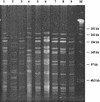Rapid identification, differentiation, and proposed new taxonomic classification of Bifidobacterium lactis
- PMID: 12450873
- PMCID: PMC134397
- DOI: 10.1128/AEM.68.12.6429-6434.2002
Rapid identification, differentiation, and proposed new taxonomic classification of Bifidobacterium lactis
Abstract
Identification of Bifidobacterium lactis and Bifidobacterium animalis is problematic because of phenotypic and genetic homogeneities and has raised the question of whether they belong to one unique taxon. Analysis of the 16S-23S internally transcribed spacer region of B. lactis DSM10140(T), B. animalis ATCC 25527(T), and six potential B. lactis strains suggested two distinct clusters. Two specific 16S-23S spacer rRNA gene-targeted primers have been developed for specific detection of B. animalis. All of the molecular techniques used (B. lactis or B. animalis PCR primers, enterobacterial repetitive intergenic consensus PCR) demonstrated that B. lactis and B. animalis form two main groups and suggest a revision of the strains assigned to B. animalis. We propose that B. lactis should be separated from B. animalis at the subspecies level.
Figures





Similar articles
-
Rapid identification of potentially probiotic Bifidobacterium species by multiplex PCR using species-specific primers based on the region extending from 16S rRNA through 23S rRNA.FEMS Microbiol Lett. 2005 Sep 1;250(1):55-62. doi: 10.1016/j.femsle.2005.06.041. FEMS Microbiol Lett. 2005. PMID: 16039804
-
Comparative sequence analysis of the tuf and recA genes and restriction fragment length polymorphism of the internal transcribed spacer region sequences supply additional tools for discriminating Bifidobacterium lactis from Bifidobacterium animalis.Appl Environ Microbiol. 2003 Dec;69(12):7517-22. doi: 10.1128/AEM.69.12.7517-7522.2003. Appl Environ Microbiol. 2003. PMID: 14660406 Free PMC article.
-
Bifidobacterium animalis subsp. lactis ATCC 27673 is a genomically unique strain within its conserved subspecies.Appl Environ Microbiol. 2013 Nov;79(22):6903-10. doi: 10.1128/AEM.01777-13. Epub 2013 Aug 30. Appl Environ Microbiol. 2013. PMID: 23995933 Free PMC article.
-
[Application of the methods of molecular systematics to classification and identification of bacteria of the genus Bifidobacterium].Mikrobiologiia. 2008 May-Jun;77(3):293-302. Mikrobiologiia. 2008. PMID: 18683644 Review. Russian.
-
Genus- and species-specific PCR primers for the detection and identification of bifidobacteria.Curr Issues Intest Microbiol. 2003 Sep;4(2):61-9. Curr Issues Intest Microbiol. 2003. PMID: 14503690 Review.
Cited by
-
Characterization of the groEL and groES loci in Bifidobacterium breve UCC 2003: genetic, transcriptional, and phylogenetic analyses.Appl Environ Microbiol. 2004 Oct;70(10):6197-209. doi: 10.1128/AEM.70.10.6197-6209.2004. Appl Environ Microbiol. 2004. PMID: 15466567 Free PMC article.
-
Exploring the diversity of the bifidobacterial population in the human intestinal tract.Appl Environ Microbiol. 2009 Mar;75(6):1534-45. doi: 10.1128/AEM.02216-08. Epub 2009 Jan 23. Appl Environ Microbiol. 2009. PMID: 19168652 Free PMC article.
-
The ClgR protein regulates transcription of the clpP operon in Bifidobacterium breve UCC 2003.J Bacteriol. 2005 Dec;187(24):8411-26. doi: 10.1128/JB.187.24.8411-8426.2005. J Bacteriol. 2005. PMID: 16321946 Free PMC article.
-
Exploration of the genomic diversity and core genome of the Bifidobacterium adolescentis phylogenetic group by means of a polyphasic approach.Appl Environ Microbiol. 2013 Jan;79(1):336-46. doi: 10.1128/AEM.02467-12. Epub 2012 Oct 12. Appl Environ Microbiol. 2013. PMID: 23064340 Free PMC article.
-
Transport of glucose by Bifidobacterium animalis subsp. lactis occurs via facilitated diffusion.Appl Environ Microbiol. 2008 Nov;74(22):6941-8. doi: 10.1128/AEM.01280-08. Epub 2008 Sep 12. Appl Environ Microbiol. 2008. PMID: 18791026 Free PMC article.
References
-
- Bourget, N. L., H. Philippe, I. Mangin, and B. Decaris. 1996. 16S rRNA and 16S to 23S internal transcribed spacer sequence analyses reveal inter- and intraspecific Bifidobacterium phylogeny. Int. J. Syst. Bacteriol. 46:102-111. - PubMed
-
- Cai, Y., M. Matsumoto, and Y. Benno. 2000. Bifidobacterium lactis Meile et al. 1997 is a subjective synonym of Bifidobacterium animalis (Mitsuoka 1969) Scardovi and Trovatelli 1974. Microbiol. Immunol. 44:815-820. - PubMed
-
- Jian, W., L. Zhu, and X. Dong. 2001. New approach to phylogenetic analysis of the genus Bifidobacterium based on partial HSP60 gene sequences. Int. J. Syst. Evol. Microbiol. 51:1633-1638. - PubMed
MeSH terms
LinkOut - more resources
Full Text Sources
Other Literature Sources
Molecular Biology Databases

